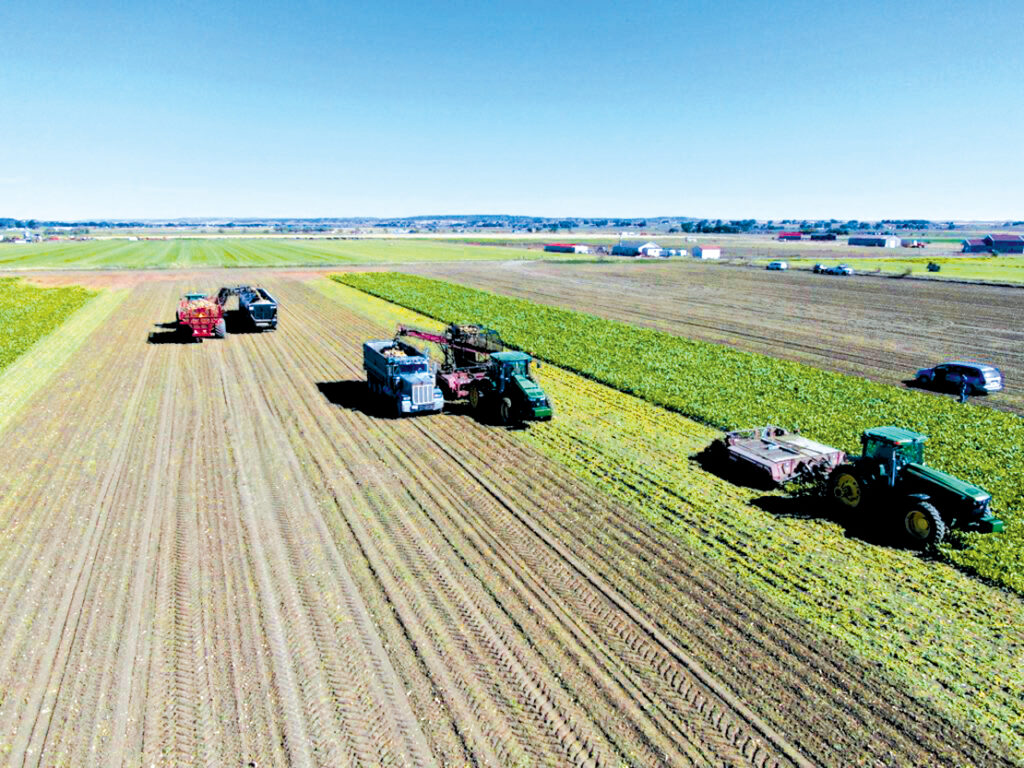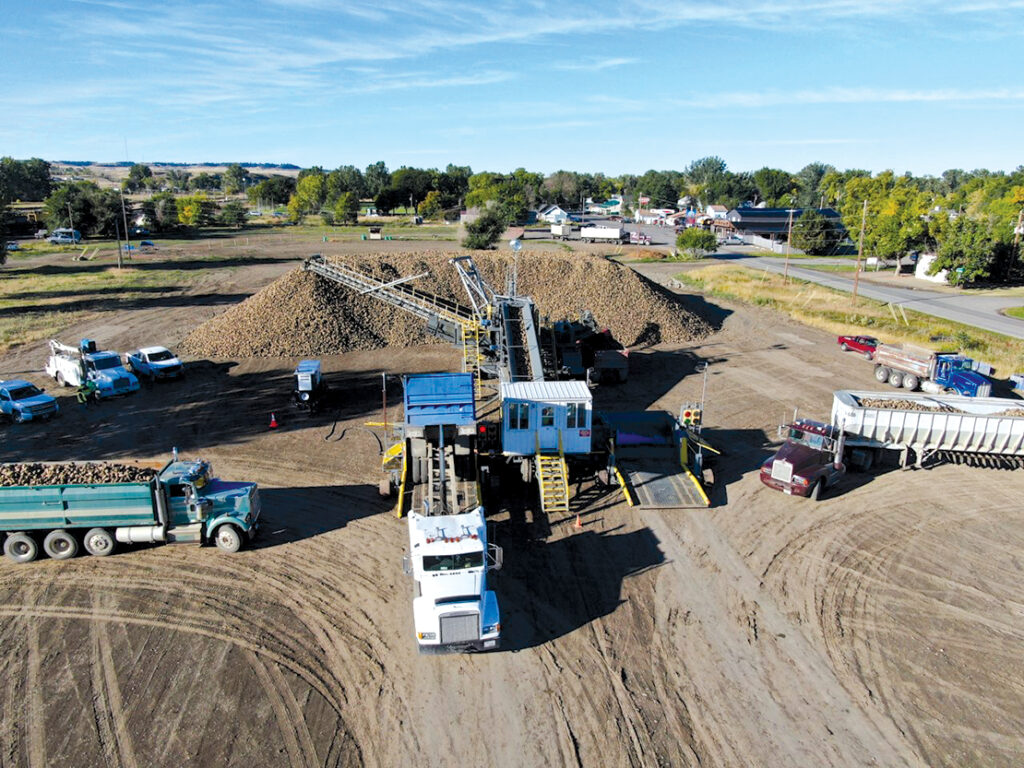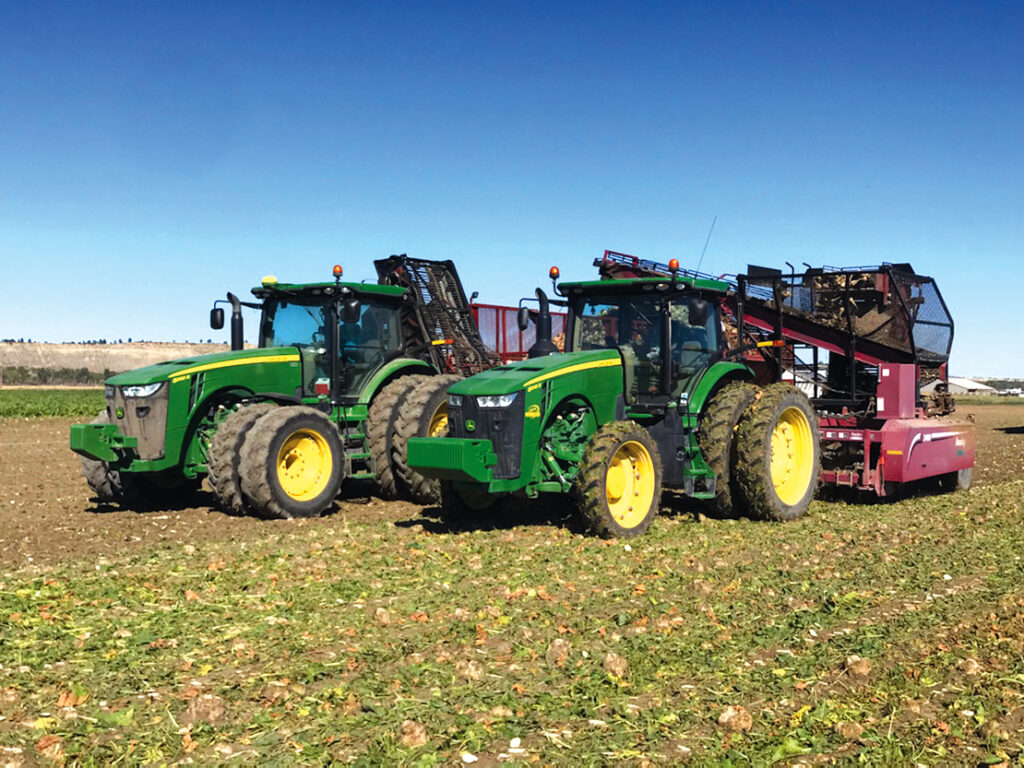
The Ewen farm crew is in full harvest mode as multiple stages of this year’s beet harvest is captured in one picture Tuesday September 21 as early harvest was underway. Guy Smith, to the right, is driving the beet defoliator which defoliates (cuts) the top of the beets. Mike Krum, in the middle tractor, pulls the beet digger in order to extract the beets out of the ground while he loads Butch Ewen in the double axel tandem truck with beets to haul to the Huntley beet dump. Garret Smith drives the beet cart, left, and loads Shawn Smith in the semi truck and other trucks in order to keep all five trucks moving continually. (Drone Image by Jonahan McNiven)
The early beet harvest began on September 1st as well as factory operations. The State of Montana has completed 16% of the sugar beet harvest thus far “…Quality is excellent this time of year,” stated Randall Jobman, Vice President of Agriculture, North Region for Western Sugar since 2007. “Regular harvest begins the first week of October as conditions allow,” he said.
Western Sugar Cooperative (WSC) has 800 shareholders/growers that own 134,150 shares of the cooperative, governed by an elected Board of Directors. The board works alongside the management team in order to sort the matters of business per the bylaws and articles of incorporation. WSC’s commitment to making a positive impact in our communities is evident by the fact that there are fourth and fifth generation growers.

Butch Ewen, left, waits in the green truck ready to unload his beets at the Huntley Beet Dump Tuesday, September 21 as trucks unload into the beet piler machine which receives beets from two different trucks at a time to place in the newly forming beet pile. Shawn Smith, right, is positioning next to unload his beets as another truck leaves. (Drone Image by Jonathan McNiven)
Butch Ewen, a farmer in Ballantine, has been farming sugar beets for roughly forty-eight years. Technology has made it “…so much easier. Equipment has gotten bigger, the guidance systems (GPS) has made it so much easier, and the Roundup ready beets has made beet farming a lot easier. Each grower has so many tons.” The Ready Beets keeps the weed production down, thus keeping the crop optimal for harvest. Ewen said, “If the weather conditions are not right, you end up fighting those weeds. Once they turn into rags, then you get charged more due to the waste in your beets.”
Ewen and three others: Mike Krum, Shawn Smith, and Guy Smith, all work and contribute to the 500 acres of sugar beets contracted to harvest for the cooperative. These growers are experts in their field. There is a commitment to provide exceptional crops, lending true to the fact that local growers are indeed a large part of our community’s agricultural heritage.

While waiting for trucks and semis to return from the Huntley Beet dump, Mike Krum extracts the beets out of the ground, right, and then fills the beet cart, to his right, driven by Garrett Smith. Any broke down equipment halts the whole process. (Photo by Jonathan McNiven)
In explaining the process, Ewen said, “Production is weighed, and run through a cleaner and piler. Then we get a tare weight off of that load each time.” Tare is anything other than a sugar beet, dirt, weeds, etc… The beets go through several cleaning processes before starting to cook.” The beets are sampled and unloaded then placed into storage thus ensuring the beets retain the sugar content. The beets are piled below 55 degrees in order to keep the piles cool, and prevent loss. Beets are later trucked from the piles to the factory for processing. The beets are then washed of all dirt, rocks, weeds and sand before they can be fed to the slicers.
Sugar is removed from the beets by flushing the beets with hot water. After the sugar is removed is when the pulp is magically turned into feed for livestock. Evaporators are then used to concentrate the juice into a dark molasses syrup. This is then crystalized, and the mixture goes onto the centrifuge where the sugar crystals are separated from the molasses by spinning the sugar against a screen while the molasses spins through the screen. Then the sugar is conveyed to the granulator for further drying. It is then packaged or stored to be sold in bulk.
On Tuesday, Ewen said, “We start tomorrow again hauling to Pompeys for early harvest. The white sugar is what makes the money. We never used to start the factory until the first week of October, but now we can process more sugar earlier. If the piles don’t keep, they could be done in January and February.” There are beet piles at Pompeys, Huntley, Custer, Billings-Moss Main, Billings factory, a pile outside of Forsyth, Bridger, Leslie, St. Xavier, North Valley, Hardin and Hysham.
Western Sugar Co-op is owned by the growers here in the Yellowstone Valley. They each bought shares to grow the sugar beets, and then they fill that quota. “We each bought so many shares to grow, and we each have to grow those shares every year,” said Ewen. Making sure not to grow too much or too little yet still have the factory moving at capacity. Being contracted with the Western Sugar Cooperative the growers cannot sell their sugar beets to anyone else, not that they would want to as they have a pretty good thing going on.
The sugar beet is two crops in one with its principal product being sugar for human consumption. We have all made cakes and cookies out of this sugar. The co-products or by-product of the sugar beet extraction process, otherwise known as pulp is pressed or pelleted, which in turn is made into a high-energy feed for livestock. Western Sugar Cooperative is exceeding industry standards with quality feed products for livestock producers.
Sugar beet growers are ready to begin harvesting as “they only keep so long and if you have a few beets that are bad they can turn the other,” stated Ewen. The idea is to get the processing done before the product goes bad. Ewen told YCN, “You can open the beet up and taste it, but it doesn’t taste sweet; it actually tastes kind of tart; it takes processing to make the sugar.”
Driving in and around Billings you can’t help but smell of the sweet aroma of the sugar beet factory processing the sugar beets. For some it’s an indication of fall, with Halloween right around the corner. For others, meaning the growers, they call it the “Smell of money.”

